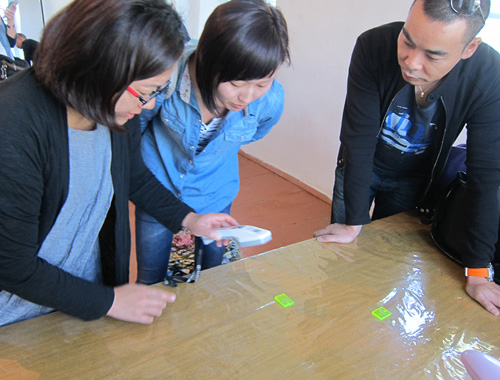#03 Challenges encountered making the felt card case
This project was full of challenges that we do not usually encounter in our product development procedures. Product quality was a significant challenge as the 35 communities taking part in the project were scattered across a periphery of 700 km. Inspection was another issue, and in this edition, we would like to introduce the challenges and efforts made towards finalizing the card case, together with details on the embroidery process.
1.Challenges encountered with size and shape
The card case was a new challenge for the communities compared to the phone case created in 2011. It had a smaller variance allowance, and in addition, the product had a pocket on each side, making the development procedures more complex. It was very different for the communities who are used to making the "shyrdak" (rug) and materials to cover their "yurta" (movable houses which can easily be assembled and disassembled), as they are much larger in scale and do not require such precise measurements.

Although we attempted to find a way to integrate the size and shape of the card case, it was much more difficult a challenge than expected. Training was repeated to minimize the size variance, but some out of the 35 communities, started to give up.
JICA Kyrgyz team and the leaders of each community did a close observation of the group with the highest productivity. By taking records and analyzing each process, they found that the accumulation of small and thoughtful techniques led to the quality differences in the final product. The techniques were as small as ways to tuck in excess materials, and because the product is so small, it was difficult for the people using these techniques to realize the differences.
Due to the repeated failures, once the techniques were implemented into the manufacturing process and explained at an additional training session, results quickly followed.

 Ms.Aizat, one of the leaders,
Ms.Aizat, one of the leaders,
explaining the techniques to other members.
2.Efforts concerning the "motif embroidery"
Once the body of the card case was finished, a small figure was embroidered on the face of the product. This embroidery influences the final impression of the product, and therefore is a very important process. However this also encountered difficulties, as this time we lacked the number of people who could skillfully embroider. This resulted in delays in the schedule, and to resolve this, templates of the motif were handmade to increase the number of persons.


Three motifs where chosen for the embroidery. The first was "Argali", a wild sheep living in the mountains of central Asia, meaning wealth, speed and flexibility. The second was "Sun Person", meaning success and wisdom, and the third, "Dancer", meaning merriment and festiveness.
 Motif drawings. The upper drawing is "Argali",
Motif drawings. The upper drawing is "Argali",
lower left corner "Sun Person", and lower right corner "Dancer".
These motifs can often be seen as ancient drawings drawn on stones in Kyrgyz.
 An ancient drawing drawn on stones (petroglyph).
An ancient drawing drawn on stones (petroglyph).
3.Inspection
Inspection is the final process before shipment. All products are inspected and examined to see whether specifications were met. During this stage, sizes and contaminations were checked to equalize the quality of the products. Small contaminated substances were removed using tweezers, and all products went through metal detection inspection on site in Kyrgyz for any residuals left.

 Ms.Bermet at the metal detection training session,
Ms.Bermet at the metal detection training session,
making the inspection process possible on site.
The products which passed the inspection process were then shipped and have been received in Japan this August.
Product development includes schedules and specifications which need to be met, and final inspections which need to be cleared. Logistic systems need to be safe and speedy, and as a result of all the procedures, the products finally arrive at our stores. Now that we have received the products from the 35 communities in Kyrgyz, we are in our final preparation stages before sending the products out.
A little more time and the products will meet you in one of our stores worldwide.
Information
Kyrgyz was one of the first countries which supported us during the earthquake disaster last year in Japan. In return, on August 5th, a charity event was held in Miyagi Japan to raise funds for baby cherry blossom trees to be sent to Kyrgyz as a symbol of friendship.
As a supporter of this event, Ryohin Keikaku took part in this even by sending handmade felt items from Kyrgyz in hope that this event will strengthen the relationship of the two countries.
This column has been written by a MUJI project member with the cooperation of JICA Kyrgyz.



